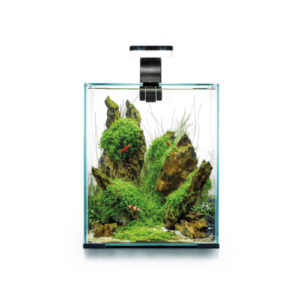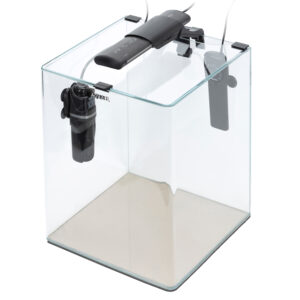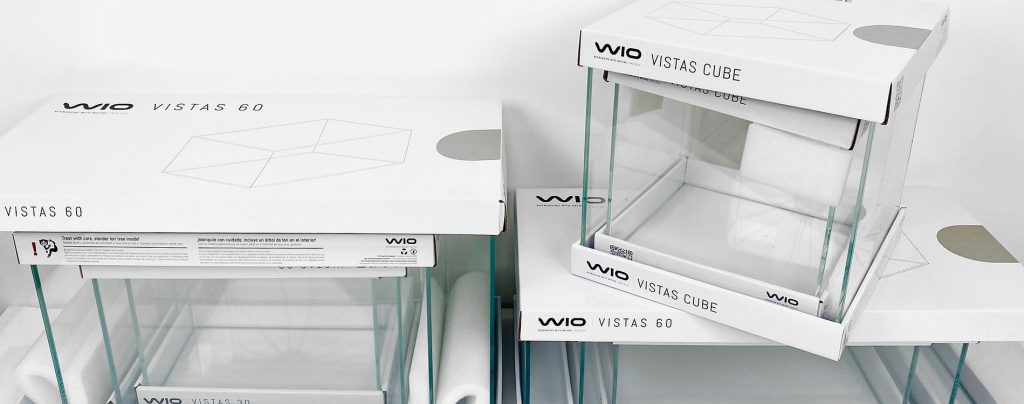A Guide To Nano Aquariums

A Guide To Nano Aquariums
Why go nano?
Nano aquariums are becoming increasingly popular. With their diminutive dimensions and lower running costs they are the perfect gateway to aquascaping. They are also a great solution for the addicted aquascaper to squeeze in just one more tank.
Cost can be a major factor when it comes to setting up an aquarium, not only when buying the glass tank and stand, but also all the equipment (filter, heater, light etc) and aquascaping materials (substrate, wood, rocks, plants, etc). With a nano aquarium setup not only is the initial cost reduced, but also the ongoing running costs and inevitable rescapes when the aquascaper feels inspired to get creative again.
What are the options?
With so many options on the market it can be a little daunting when it comes to choosing the perfect setup for you. First work out where your nano tank is going to be placed. The smaller size and reduced weight often means that a specialised aquarium stand may not always be necessary. However, all aquariums must be placed on a solid, sturdy surface, even a 20 litre tank can weigh 20kg or more, so a robust desk or table is a must.
Now that you know how much space you have you can start to narrow down your options. Complete kits are a great place to start. Polish company Aquael offer some incredible, high quality and fantastic value nano kits. These kits include a glass tank with lid, filter, heater, base mat and LED lamp, so all that’s left to choose is the scaping materials and livestock.

Another option would be to build your own setup. This method opens you up to a plethora of different styles and sizes. Beautiful, ultra clear glass tanks from manufacturers such as Wio, Strideways and Dennerle provide the ultimate vessel in which to build your aquascape. These tanks can be accessorised with equipment of your choosing, whether you go for a high-tech setup with bright lighting and CO2 (see our guide to CO2 HERE) or a simpler, but still beautiful, low-tech setup.

Substrates
Often the best choice for substrate is aquarium soil. Soils are a complete substrate which provide the ideal growing medium for aquatic plants. They also help to lower PH and lock in essential nutrients. For nano aquariums consider using a soil with a smaller grain size such as Tropica Aquarium Soil Powder. The smaller grain size will help with the sense of scale and some smaller foreground plants have less chance of pulling free of the substrate and floating to the top in the first few days after planting.
Other planting mediums such as Tropica Plant Substrate are designed to be capped with sand. These can be a great option if you’re looking to use a cosmetic sand to add to the aesthetic of your aquascape. Look out for manufacturers such as Wio and Hugo Kamishi for some beautiful cosmetic natural sands.
Choosing hardscape
Small tanks require less in the way of woods, rocks and substrate. This can mean that it is possible to really build up a strong hardscape for a fraction of the cost of a larger tank. For increased sense of scale choose rocks with finer details. Seiryu, Dragon, Geo, Millennium and Grey Mountain Rock are all great options for nano scapes. Likewise, woods with that lend themselves well to use in nano aquariums are Nano Redmoor, Slim Wood, Structure Wood and Manzanita. Remember, wood can be broken or sawn to remove any branches which may prevent the piece from fitting in the tank, just take care not not have the sawn edges in clear view so as not to take away from the natural feel of the scape.
Another option for nano tanks is to use just one centre piece of hardscape. A single epic piece of wood or magnificent rock placed front and centre can be just as effective as an intricately constructed hardscape. This option is perfect if you are just starting out and your confidence to build the perfect layout is not quite so high.
Plant selection.
Plant selection can be a little more restrictive in a nano aquarium. Fast growing stem plants will need regular trimming and can often become overgrown and take over. Choosing smaller, slower growing plants will make maintenance easier and increase the longevity of the scape. Smaller epiphyte plants such as Anubias petite, Anubias nana ‘mini’ and Bucephalandra species are options which lend themselves beautifully to nano tanks. Aquatic mosses and small carpeting plants such as Eleocharis acicularis ‘Mini’, Micranthemum tweedii ‘Monte Carlo’ and Marsilea hirsuta also work very well for planting the foreground. Fine leaved plants such as Rotala rotundifolia ‘H’ra’ and Myriophyllum species work well to keep everything in scale at the back. Many more plant options are available. For lower light, no CO2 setups it is best to stick to ‘Easy’ rated plants, this will ensure successful, healthy plant growth.
Livestock
A small aquarium can be limiting with regards to livestock. The perfect choice for nano tanks is freshwater shrimp. There is a multitude of stunning shrimps available, from the more sensitive Caridina shrimp such as the Crystal Bee and Blue Bolt, to the more hardy and wallet friendly Neocaridina “Cherry Shrimp”.
There are some fish which will be suitable for a nano tank. Betta fish are the obvious choice. With their beautiful flowing fins and often lazy lifestyle, they are the ideal inhabitant for the planted nano aquarium. Other options include Boraras brigittae, Boraras maculatus, Danio margaritatus, Corydoras pygmaeus or Carinotetraodon travancoricus (Dwarf puffer fish). Always research your fishes water parameter requirements and compatibility with other tank mates before purchasing.
Maintaining your nano tank.
Despite being small, maintenance is still very important. In fact, nano aquariums can often be more prone to issues relating to water parameters. Waste and excess nutrients can build up quickly in a small body of water. Regular weekly water changes of 20 – 50% will keep your nano tank in top condition. Take care to remove any dead plant matter and carefully siphon out detritus. Keep an eye on water temperatures as this too can fluctuate in extreme weather conditions. That said, given the small volume of nano aquariums, maintenance is quick and easy, giving you more time to enjoy your aquascape.



